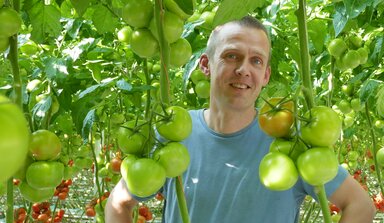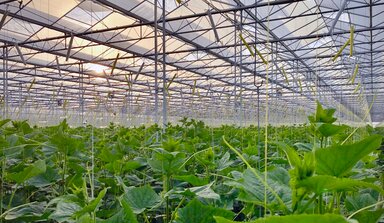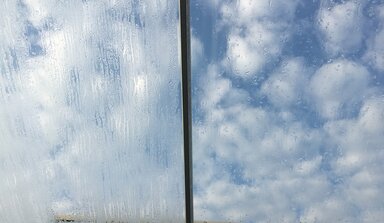Preventing light loss and disease in plastic greenhouses
Condensation on the greenhouse roof is the result of air dehumidification. In plastic greenhouses steps need to be taken to prevent the condensation from causing problems.
The air inside a greenhouse or tunnel is often very humid. Therefore, in principle, condensation on a cold roof is a beneficial process: Condensation removes moisture. In addition energy is released that previously was used to evaporate the water. This is called latent heat. Release of latent heat means that less heating is required. In addition, water is released. Calculations using a computer model show that every year 100 litres of water per square meter condense against the greenhouse roof. Ideally this water will be drained off or recycled. The amount of water that condenses depends on the humidity, the greenhouse air temperature and the temperature of the plastic roof.
Many types of plastic are hydrophobic: They repel water which results in the condensation forming large droplets. This leads to a large amount of light loss, as much as 15%. This comes at the expense of production and quality.
Disease pressure
In addition, falling droplets can cause problems. Fungal spores often require free water for their development. If the crop becomes wet due to falling droplets the presence of mould rises significantly. This also applies to some bacterial diseases.
The problem is notorious in plastic tunnels. Droplets can fall for several different reasons. Banging on the plastic leads to a rainfall of droplets. Also, not all droplets attach themselves to all angles of the plastic so some spots become wet more often. And, if the sun breaks through it can lead to massive dripping because the film suddenly warms up.
AntiCondens
To avoid these problems new films are often treated in the factory with an anti-condensation layer. However, this wears away with time. Then a grower can apply AntiCondens for plastic. The coating is suitable for plastic films, acrylate and polycarbonate covers. By spraying it on lightly as a mist to the point of run-off and then allowing it to dry leads to the best results.
The coating ensures that the condensation spreads out into a thin layer. That significantly limits the light loss and there is hardly any droplet formation.
AntiCondens is water-based and safe to use. The best time to apply the coating is when the greenhouse is empty of plants. The coating is basically safe for the majority of crops but it is always advisable to first carry out a small test on plants, just to be sure.


